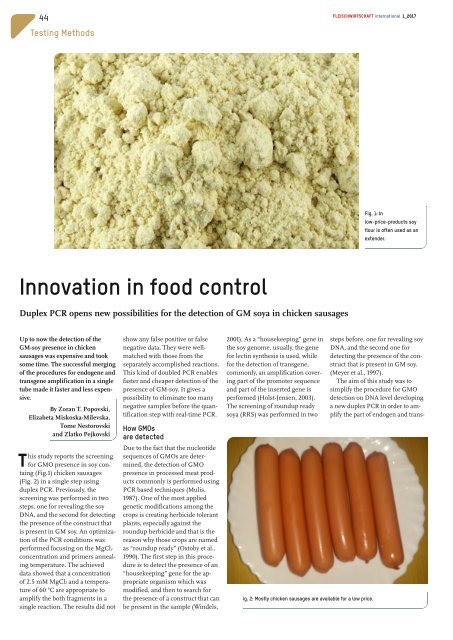FLEISCHWIRTSCHAFT international 1/2017
You also want an ePaper? Increase the reach of your titles
YUMPU automatically turns print PDFs into web optimized ePapers that Google loves.
44<br />
Fleischwirtschaft <strong>international</strong> 1_<strong>2017</strong><br />
Testing Methods<br />
Fig. 1: In<br />
low-price-products soy<br />
flour is often used as an<br />
extender.<br />
Innovation in food control<br />
Duplex PCR opens new possibilities for the detection of GM soya in chicken sausages<br />
Up to now the detection of the<br />
GM-soy presence in chicken<br />
sausages was expensive and took<br />
some time. The successful merging<br />
of the procedures for endogene and<br />
transgene amplification in asingle<br />
tubemade it faster and less expensive.<br />
By Zoran T. Popovski,<br />
Elizabeta Miskoska-Milevska,<br />
Tome Nestorovski<br />
and ZlatkoPejkovski<br />
This study reports the screening<br />
for GMO presence in soy containg<br />
(Fig.1) chicken sausages<br />
(Fig. 2) in asingle step using<br />
duplex PCR. Previously,the<br />
screening was performed in two<br />
steps, one for revealing the soy<br />
DNA, and the second for detecting<br />
the presence of the construct that<br />
is present in GM soy.Anoptimization<br />
of the PCR conditions was<br />
performed focusing on the MgCl2<br />
concentration and primers annealing<br />
temperature. The achieved<br />
data showed that aconcentration<br />
of 2.5 mM MgCl2 and atemperature<br />
of 60 °C are appropriate to<br />
amplify the both fragments in a<br />
single reaction. The results did not<br />
show any false positive or false<br />
negative data. They were wellmatched<br />
with those from the<br />
separately accomplished reactions.<br />
This kind of doubled PCR enables<br />
faster and cheaper detection of the<br />
presence of GM-soy.Itgives a<br />
possibility to eliminate too many<br />
negative samples before the quantification<br />
step with real-time PCR.<br />
How GMOs<br />
are detected<br />
Due to the fact that the nucleotide<br />
sequences of GMOs are determined,<br />
the detection of GMO<br />
presence in processed meat products<br />
commonly is performed using<br />
PCR based techniques (Mulis,<br />
1987). One of the most applied<br />
genetic modifications among the<br />
crops is creating herbicide tolerant<br />
plants, especially against the<br />
roundup herbicide and that is the<br />
reason why those crops are named<br />
as “roundup ready” (Oxtoby et al.,<br />
1990). The first step in this procedure<br />
is to detect the presence of an<br />
“housekeeping” gene for the appropriate<br />
organism which was<br />
modified, and then to search for<br />
the presence of aconstruct that can<br />
be present in the sample (Windels,<br />
2001).Asa“housekeeping” gene in<br />
the soy genome, usually,the gene<br />
for lectin synthesis is used, while<br />
for the detection of transgene,<br />
commonly,anamplification covering<br />
part of the promoter sequence<br />
and part of the inserted gene is<br />
performed (Holst-Jensen,2003).<br />
The screening of roundup ready<br />
soya (RRS) was performed in two<br />
ig. 2: Mostlychicken sausages are available for alow price.<br />
steps before, one for revealing soy<br />
DNA, and the second one for<br />
detecting the presence of the construct<br />
that is present in GM soy.<br />
(Meyer et al., 1997).<br />
The aim of this study was to<br />
simplify the procedure for GMO<br />
detection on DNA level developing<br />
anew duplex PCR in order to amplify<br />
the part of endogen and trans-

















